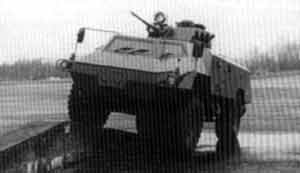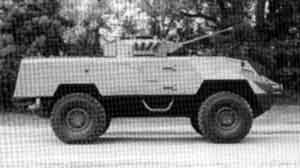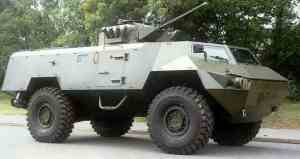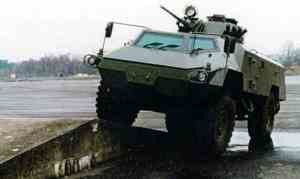| Designation: | Panther |
 |
|---|---|---|
| Manufacturer: | Greys Defence Systems Ltd | |
| Product type: | Armoured Vehicles | |
| Name: | Reconnaissance Vehicle |
The Panther (4 x 4) Multirole Combat Vehicle has been developed by Glover Webb (then owned by GKN Defence Systems) under contract to Greys Defence Systems. Glover Webb built the prototype of the Panther at its Hamble, Hampshire, facility.
This facility has now been closed and work transferred to the former GKN Defence facility at Telford, Shropshire. GKN Defence and Alvis Vehicles merged late in 1998 with the company now known as Alvis Vehicles.
It has been developed as a private venture to fill a gap in the market for a more capable wheeled reconnaissance system which can carry out sustained reconnaissance missions of at least 48 hours.
Design work on the Panther started in 1996 and was preceded by a 4 x 4 automotive demonstrator. As well as being marketed overseas, Panther will be marketed to the UK as a candidate for the future command and liaison vehicle requirement which will replace obsolescent tracked and soft-skinned liaison vehicles.
The prototype of the Panther was completed in late 1997 and configured as a reconnaissance vehicle and fitted with a Helio FVT 925 turret armed with The Boeing Company 25 mm M242 cannon and 7.62 mm coaxial MAG machine gun.
Following its first public showing in September 1997, the Panther undertook extensive mobility/user trials in the UK.
As of early 1999, no production orders for the Greys Defence Systems Panther had been announced.
A Lockheed Martin C-130H should carry one Panther while the C-130J the projected, Future Large Aircraft (FLA), should be capable of carrying two vehicles.
The hull of the Panther is of all-welded steel armour construction which provides all-round protection from 7.62 and 5.56 mm armour-piercing and 12.7 mm ball attack with the windows providing the same level of protection as the hull.
The steel armour also provides protection against 155 mm airburst artillery projectiles at a range of 50 m. The angled boat shape of the lower hull provides blast protection from hand grenades and, according to Greys Defence Systems, the hull shape also provides maximum protection for the drive train of the vehicle.
The roof and body interior are insulated with fire-resistant foam with a thickness of 40 mm and the floor is fitted with non-slip material.
The driver is seated at the front of the vehicle and is provided with an adjustable seat which reclines to enable the driver to rest. The driver has powered steering and also operates the winch and water-jets from his position. The windscreen to the front and sides provides the same level of protection as the hull.
The vehicle commander is seated to the rear of the driver on the left side and has a single-piece hatch cover that opens to the rear.
In either side of the hull is a single door that opens to the front; to the rear of this is a vision block. Various combinations of vision blocks and/or firing ports are available for the Panther depending on user requirements.
When used in the reconnaissance role, the vehicle normally has a crew of five or six, commander, driver and gunner and three additional people. Three seats are provided for the latter, one to the right of the right side door facing inwards and two at the rear facing the front. The seating arrangements depend on the mission.
Mounted on the hull roof in the centre is the Helio FVT 925 turret which has been produced in significant numbers for the export market.
This turret is armed with The Boeing Company 25 mm M242 Chain Gun with a 7.62 mm machine gun being mounted coaxial. Mounted either side of the turret is a bank of four electrically operated grenade launchers which can launch a variety of grenades including smoke and fragmentation. The turret can be fitted with various day/night observation devices and mounted coaxial with the weapons is a white light searchlight.
To enable Panther to carry out its primary mission of reconnaissance beyond the direct sightline, it is provided with a Clark KT14 telescopic mast at the rear of the hull on the left side.
On top of this mast is a sensor pod fitted with a Pilkington Optronics HDTI (High-Definition Thermal Imager) and a day camera. Production systems would also have an eyesafe laser range-finder.
The sensor pod can be operated by remote control from within the vehicle with the control panel including two monitors, one for each camera. Provision will be made to transmit information and pictures in near-realtime to the next chain of command. The sensor pod. developed by Kylmar has growth potential to auto-tracking. A global positioning system can be fitted if required.
The engine compartment is at the rear of the Panther and separated from the crew compartment by a bulkhead. As the vehicle has been configured for the reconnaissance role, the rear-mounted power pack helps to reduce the thermal signature of the vehicle. The air inlets are in the roof of the vehicle with the air outlet at the rear.
The power pack consists of a Caterpillar water-cooled turbocharged diesel engine developing 350 hp coupled to an Allison MD 3066 fully automatic transmission with five forward and one reverse gears and a two-speed Steyr VG 750 transfer box. Steering is power assisted on the front wheels.
The engine compartment has a manually operated fire suppression system with an alarm/sensing system fitted as standard.
Panther has three differential locks, transfer box, front and rear axles. The transfer box differential lock is automatically engaged when low range is selected. The front and rear axle differential locks are operated by the driver from a dashboard rocker switch.
Both front and rear axles have Rockwell fully independent double-wishbone coil suspension with hydraulic dampers.
A central tyre pressure regulation system allows the driver to adjust the tyre pressure to suit the terrain being crossed. Run flat inserts are fitted as standard.
The split brake system is fully air powered and is fitted with an automatic drain system. The parking brake, applied from the driver's position, operates on both front and rear axles.
The 240-litre fuel tanks are filled with the Explosafe explosion suppression system and give the vehicle a maximum road range of about 750 km.
Panther is fully amphibious being propelled in the water by two Ultra water-jets mounted one either side at the rear. A front-mounted 6,500 kg hydraulically operated winch is provided for self-recovery or for the recovery of other vehicles.
Standard equipment includes passive night vision equipment for the commander and driver, air conditioning system, NBC system, NATO standard tow hook, boiling vessel, water tank, heater/demister and a tactical reversing camera.
Although the prototype of the Panther has been configured as a reconnaissance vehicle with a crew of four, an additional two crew can be carried if required. Other missions suggested for the Panther include air defence (gun and/or missile), forward observation, liaison, military police, anti-tank guided missile platform, CI, NBC survey and signals. A wide range of other turrets and weapons can be fitted.
Prototype.
|
||||||||||||||||||||||||||||||||||||||||||||||||||||||||||||||
|
||||||||||||
Related Articles |
|
Tactical Satellite VSAT Communication (04.05.2015) |
|
New protection system for K-2 to be developed this year (30.03.2011) |
|
New contract for more armoured fighting vehicles (23.03.2010) |
|
TERRIER Engineer vehicle passes two key milestones (19.02.2010) |
|
Preparing vehicles for Afghanistan in UK (11.11.2009) |
|
Ground troops and pilots train for Afghanistan in simulator (02.11.2009) |
|
Iveco to showcase vehicle technology at the International Armoured Vehicles Event 2010 (21.10.2009) |
|
Testing the latest armoured vehicles for Afghanistan (01.09.2009) |
|
Modified Panthers Take a Bow In Afghan Theatre (13.05.2009) |
|
Iveco Defence Vehicles Exhibits Its Protected Vehicle Range at IDET 2009 (10.04.2009) |
|
Austrian Army Orders 150 IVECO LMV (20.01.2009) |
|
Technology and safety of the light multirole vehicle (lmv) in all markets (04.01.2008) |
|
Bazooka (06.09.2007) |
|
New Defence Coating for British Army Vehicles (08.12.2006) |
|
Mine-Resistant Iveco MLVs to be supplied to Norway (31.03.2006) |
 |
 |
 |
 |
